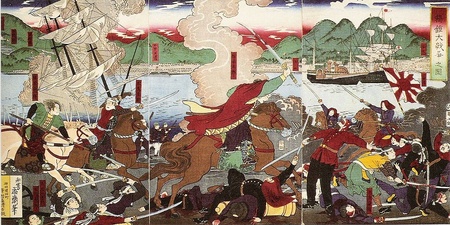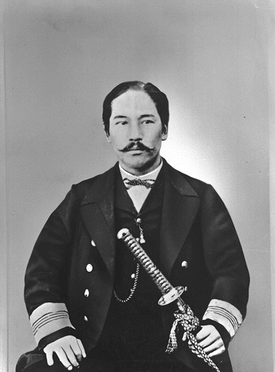Japanese overseas immigration, which began with the Meiji Restoration, marked 150 years in 2018 since the first group arrived in the Kingdom of Hawaii. Many Japanese people subsequently emigrated to the mainland United States and Central and South America. The first immigrants to Mexico were the Enomoto Colonization Group, which settled in Escuintla, Chiapas in 1897. This group was promoted by Enomoto Takeaki, former Minister of Foreign Affairs of the Meiji government. However, many of the immigrants fled the colony within a year due to a lack of prior research, incomplete information on the land and climate, and a lack of funds. In 1901, the colony virtually collapsed. However, six immigrants who remained in the area established a Japan-Mexico Collaboration Company. Despite being affected by the civil war caused by the Mexican Revolution, the Enomoto Colonization Group is still well known today for its great contributions to Mexican society through various businesses1 . In this article, we will look at how Enomoto Takeaki lived during the turbulent times from the end of the Edo period to the Meiji Restoration, and why he sent a colonization group to Mexico.
Enomoto Takeaki in the late Edo period
Enomoto Takeaki was born in Edo in 1836 as the son of a shogunate official. He studied Confucianism from his youth and entered the shogunate's Shoheizaka Academy to become a government official. He then studied gunnery, Dutch, and English at private schools. At the age of 21, Enomoto entered the Nagasaki Naval Training School, and Dutch Navy Lieutenant Commander Huijssen van Kattendijke highly praised his enthusiasm and hard work in both his studies and work. He later studied naval warfare at a private school in Yokohama, and in 1858 was appointed professor at the Naval Training School.
In 1861, the shogunate decided to purchase three warships from the United States and send students to the United States, but due to the effects of the Civil War this did not come to fruition, so the order was changed to the Netherlands, and the destination of the study abroad was also changed. Enomoto, who was selected as one of the 15 students to study abroad, learned about naval operations, gunnery, steam engine science, science, physics, mathematics, and the "Compendium of International Maritime Law" (International Law of the Sea), and also had the opportunity to observe the military forces of major European countries. In 1866, he returned to Japan, and the following year he was appointed captain of the state-of-the-art warship "Kaiyo Maru" purchased in the Netherlands, and was later promoted to vice-president of the shogunate's navy. However, during that time, Tokugawa Yoshinobu declared the return of imperial rule to the emperor, and in 1868 a new government was established by the restoration of imperial rule. The Tokugawa shogunate, which had lasted for 260 years, effectively collapsed, and Enomoto, who had been a member of the shogunate's army, also became a traitor.
Later, as the Boshin War between the former Shogunate forces and the new government escalated, Enomoto led eight of the Shogunate's major warships against the new government at Goryokaku in Hakodate, but was forced to surrender after a fierce battle. As the supreme commander, Enomoto decided to commit suicide, but was stopped by his aides, and surrendered to Kuroda Kiyotaka of the government forces. After that, he was in a situation where he would have been executed, but Kuroda, who had a high opinion of Enomoto's talent, pleaded for his life, and he was pardoned by the Meiji government in 1872, and he was released. He went on to hold various government positions.

From the Hokkaido Development Commission to the Bureaucracy
After being released, Enomoto was appointed as a fourth-class official of the Hokkaido Development Commission (1872-73) at the strong request of the Hokkaido Development Commissioner Kuroda, and he fully utilized his knowledge of mineralogy to conduct mine (coal) surveys in Hokkaido. After completing his duties in Hokkaido, Enomoto signed the Treaty of Exchange of Sakhalin for the Kuril Islands as the envoy extraordinary and plenipotentiary to Russia (1875), and then visited Germany, France, Britain, and Russia, and crossed Siberia.
He held important government positions, including Assistant Minister of Foreign Affairs (1879), Lord Admiral (1880), and Envoy Extraordinary and Plenipotentiary to China (1881-85). After the cabinet system was established in 1885, he served as the first Minister of Communications (1885-88), Minister of Education (1889-90), Minister of Foreign Affairs (1891-92), and Minister of Agriculture and Commerce (1894-97). Enomoto was the only former shogunate official to serve in the first cabinet.
In 1887, he was awarded the title of Viscount by the Emperor, and the previous year he was awarded the Grand Cordon of the Order of the Rising Sun, First Class. In 1889 he was also awarded the Medal of Honor commemorating the promulgation of the Constitution of the Empire of Japan. He was also awarded other decorations by the Russian Empire, the Kingdom of Italy, the Qing Empire, the Kingdom of Portugal, the Kingdom of Hawaii, and others.
Promoting overseas colonization projects
Enomoto, ever since his survey of Hokkaido as a pioneer, felt a sense of crisis that Japan's limited mineral resources and arable land area could not meet the needs of the ever-growing population, and he always advocated the need for overseas colonization. As a solution to the population increase, he recommended the government to relocate criminals to the Ogasawara Islands and to purchase the Spanish territories of Ladrone Islands (now the Mariana Islands) and Peleliu Island, and actually made this happen. In 1879, he founded the Tokyo Geographical Society and proposed purchasing Borneo and New Guinea and relocating Japanese there, and as a Privy Councilor, he submitted a proposal to the Cabinet for immigration to Mexico.
In 1891, Enomoto was appointed as the successor to Aoki Shuzo, who was the Minister of Foreign Affairs at the time, and established a department called the "Immigration Division" within the Minister's Secretariat of the Ministry of Foreign Affairs. He then ordered the collection of information on several countries (such as New Guinea and the Malay Peninsula) in order to advance the policy of overseas colonization. However, in 1897, Enomoto, who was the Minister of Agriculture and Commerce, resigned from his position, taking political responsibility for the Ashio Copper Mine Pollution Incident, and Enomoto's 20-year career in politics came to an end. In the end, he was unable to send any immigrants during his time as a bureaucrat.
Notes:
1. Regarding the achievements of the Enomoto Colonization Group, a manga version of "Samurai-tachi no Mexico" ("Samurai's Mexico") has been published in both Japanese and Spanish. It clearly summarizes the hardships and perseverance of Japanese immigrants to Mexico, the history of immigrants who were busy with revolutions and wars, and how they built the foundation for the trust that exists today.
© 2019 Alberto J. Matsumoto







